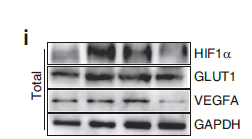
主要信息
Target
Msx-2
Host Species
Rabbit
Reactivity
Human, Mouse
Applications
WB, IHC, IF, ELISA
MW
28kD (Observed)
Conjugate/Modification
Unmodified
货号: YT2905
规格
价格
货期
数量
200μL
¥3,780.00
现货
0
100μL
¥2,300.00
现货
0
40μL
¥960.00
现货
0
加入购物车


已收藏


收藏
详细信息
推荐稀释比
WB 1:500-1:2000; IHC 1:100-1:300; ELISA 1:20000; IF 1:50-200
组成
Liquid in PBS containing 50% glycerol, 0.5% BSA and 0.02% sodium azide.
特异性
Msx-2 Polyclonal Antibody detects endogenous levels of Msx-2 protein.
纯化工艺
The antibody was affinity-purified from rabbit antiserum by affinity-chromatography using epitope-specific immunogen.
储存
-15°C to -25°C/1 year(Do not lower than -25°C)
浓度
1 mg/ml
实测条带
28kD
修饰
Unmodified
克隆性
Polyclonal
同种型
IgG
相关产品
抗原&靶点信息
免疫原:
Synthesized peptide derived from the Internal region of human Msx-2.
展开内容
特异性:
Msx-2 Polyclonal Antibody detects endogenous levels of Msx-2 protein.
展开内容
基因名称:
MSX2
展开内容
蛋白名称:
Homeobox protein MSX-2
展开内容
别名:
MSX2 ;
HOX8 ;
Homeobox protein MSX-2 ;
Homeobox protein Hox-8
HOX8 ;
Homeobox protein MSX-2 ;
Homeobox protein Hox-8
展开内容
背景:
This gene encodes a member of the muscle segment homeobox gene family. The encoded protein is a transcriptional repressor whose normal activity may establish a balance between survival and apoptosis of neural crest-derived cells required for proper craniofacial morphogenesis. The encoded protein may also have a role in promoting cell growth under certain conditions and may be an important target for the RAS signaling pathways. Mutations in this gene are associated with parietal foramina 1 and craniosynostosis type 2. [provided by RefSeq, Jul 2008],
展开内容
功能:
Disease:Defects in MSX2 are the cause of craniosynostosis type 2 (CRS2) [MIM:604757]; also known as craniosynostosis Boston-type (CSB). CRS2 is an autosomal dominat disorder characterized by the premature fusion of calvarial sutures. The craniosynostosis phenotype is either fronto-orbital recession, or frontal bossing, or turribrachycephaly, or cloverleaf skull. Associated features include severe headache, high incidence of visual problems (myopia or hyperopia), and short first metatarsals. Intelligence is normal.,Disease:Defects in MSX2 are the cause of parietal foramina 1 (PFM1) [MIM:168500]; also known as foramina parietalia permagna (FPP). PFM1 is an autosomal dominant disease characterized by oval defects of the parietal bones caused by deficient ossification around the parietal notch, which is normally obliterated during the fifth fetal month.,Disease:Defects in MSX2 are the cause of parietal foramina with cleidocranial dysplasia (PFMCCD) [MIM:168550]; also known as cleidocranial dysplasia with parietal foramina. PFMCCD combines skull defects in the form of enlarged parietal foramina and deficient ossification of the clavicles.,Function:Probable morphogenetic role. May play a role in limb-pattern formation. In osteoblasts, suppresses transcription driven by the osteocalcin FGF response element (OCFRE).,similarity:Belongs to the Msh homeobox family.,similarity:Contains 1 homeobox DNA-binding domain.,subunit:Interacts with MINT (By similarity). Interacts with G22P1 (Ku70) and XRCC5 (Ku80).,
展开内容
细胞定位:
Nucleus.
展开内容
组织表达:
研究领域:
>>Human T-cell leukemia virus 1 infection
展开内容
文献引用({{totalcount}})
货号: YT2905
规格
价格
货期
数量
200μL
¥3,780.00
现货
0
100μL
¥2,300.00
现货
0
40μL
¥960.00
现货
0
加入购物车


已收藏


收藏
Recently Viewed Products
Clear allToggle night Mode
{{pinfoXq.title || ''}}
Catalog: {{pinfoXq.catalog || ''}}
Filter:
All
{{item.name}}
{{pinfo.title}}
-{{pinfo.catalog}}
主要信息
Target
{{pinfo.target}}
Reactivity
{{pinfo.react}}
Applications
{{pinfo.applicat}}
Conjugate/Modification
{{pinfo.coupling}}/{{pinfo.modific}}
MW (kDa)
{{pinfo.mwcalc}}
Host Species
{{pinfo.hostspec}}
Isotype
{{pinfo.isotype}}
产品 {{index}}/{{pcount}}
上一个产品
下一个产品
{{pvTitle}}
滚轮缩放图片
{{pvDescr}}




















